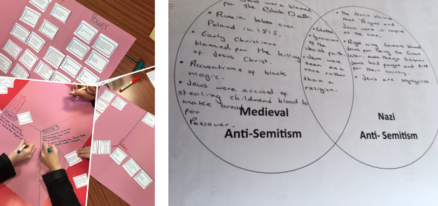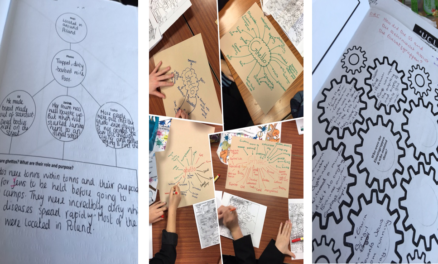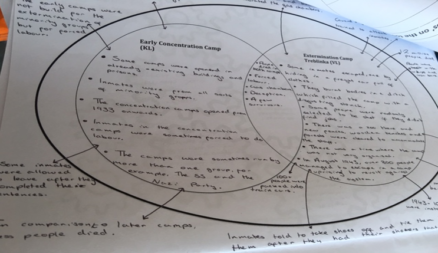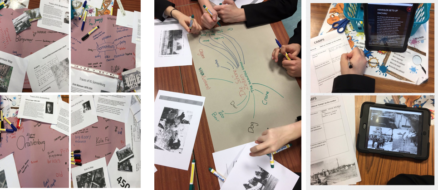Having introduced some grounding pedagogy (the Authentic Encounters approach), provided contextual background as to who the Jewish people were, and explored a definition of the Holocaust be acknowledging the persecution of other victim groups and the need to understand the intention and particularity of experience as well as the common factors, the next lesson in my scheme of learning (lesson five) as whether antisemitism began with Hitler and the Nazi Party. I wanted students to explore continuity and change in the development of anti-Jewish prejudice, to critically examine the underlying cause of anti-Jewish prejudices and provide opportunities to analyse and synthesise a range of information to advance understanding of prejudice, in general, and antisemitism in particular. Students would demonstrate their learning through constructing a venn diagram comparing medieval anti Jewish prejudice and Nazi antisemitism. This change and continuity, cause and consequence outcome would be the thanks to the Unlocking antisemitism materials from UCL.
 This was a really well-received lesson. I was particularly impressed with the levels of discussion held after watching the IWM video – The Roots of Antisemitism. The sorting activity, modelled at the Beacon School residential needed quite a bit of support from me – I am wondering if I need to put in some kind of summary activity to firm up the points made in the video? Students were able though to identify examples of medieval and Nazi anti-Semitism and recognise the differences. They engaged with the group activity well, although marking their work suggests they may need further guidance. All of the students were able to work together as a group to come up with three key features of each, so perhaps the focus of the marking should be on this? Perhaps I need to design not a Venn diagram, but a version of the ‘Three Keys’ sheets?
This was a really well-received lesson. I was particularly impressed with the levels of discussion held after watching the IWM video – The Roots of Antisemitism. The sorting activity, modelled at the Beacon School residential needed quite a bit of support from me – I am wondering if I need to put in some kind of summary activity to firm up the points made in the video? Students were able though to identify examples of medieval and Nazi anti-Semitism and recognise the differences. They engaged with the group activity well, although marking their work suggests they may need further guidance. All of the students were able to work together as a group to come up with three key features of each, so perhaps the focus of the marking should be on this? Perhaps I need to design not a Venn diagram, but a version of the ‘Three Keys’ sheets?
Moving on to lesson six I wanted students to have a sense of space and scale of the Holocaust and to understand the chronology, geography and purpose of ghettos. Likewise to provide students with the chance to investigate the locations and actions of the Einsatzgruppen and those who assisted them. Much of this resonated with 2016 UCL student research findings – particularly the issues raised in the 4th of the research briefings: Spaces of Killing.
After looking at the objectives for these lessons, I divided this in to two distinct lessons, based upon the geography of the Holocaust and added a HW activity, which allowed students a research opportunity and a creative task. On reflection, the term ‘ghetto’ could easily take 3-4 lessons, although students did work very well within the time given. They interacted really well with the case studies I gave them – by this point they are showing a real willingness to read everything given to them and groups are naturally working well. The scaffold diagram was really useful in breaking down the task of reading the Case Studies – perhaps I could look at something like this for the timeline lesson? The standard of research and HW for this topic was really good. I decided to focus on ‘What does the word ghetto mean to you?’ to try to get students to start developing their own thoughts about a particular term. The response to this HW was extremely diverse, which was different to HW that we normally ask for – we would normally ask for something and receive something that looked the same across the board – this time I wanted to give students the opportunity to respond in a way that they felt was appropriate. Some wrote, some drew, some painted, some created spidergrams, some collaged – it was great to receive so many different responses to the same question. This research has got me thinking about active research in the classroom – is there room for it in any of the next activities? This means I may have to replan, but if this allows students to progress further and in different ways, it should be celebrated, so I should give them the opportunity to engage with it in the classroom.
 With the second lesson, I focused on the Einsatzgruppen. I used maps with the ghettos lesson, and used the UCL maps for this lesson. I also reminded students of the events on the timeline and referred them back to the map. I am really pleased I took the time to plan and research this lesson thoroughly. I looked very carefully at information that I could use and created my own Case Studies. I really thought carefully about choosing information which was not graphic, but factual, in the same style as the Case Studies in the Timeline – What was the Holocaust UCL lesson.
With the second lesson, I focused on the Einsatzgruppen. I used maps with the ghettos lesson, and used the UCL maps for this lesson. I also reminded students of the events on the timeline and referred them back to the map. I am really pleased I took the time to plan and research this lesson thoroughly. I looked very carefully at information that I could use and created my own Case Studies. I really thought carefully about choosing information which was not graphic, but factual, in the same style as the Case Studies in the Timeline – What was the Holocaust UCL lesson.
Students completed an inference triangle to show evidence of source analysis, the ‘What Do Sources Tell Us About Ghettos?’ diagram and the cogs diagram to show a multi-faceted answer to the question ‘Who were the Einsatzgruppen and who assisted them?’ Examples of their change and continuity, cause ad consequence and source analysis outcomes can be found here:
Lesson seven in my scheme would focus upon developing students understanding of the operation of concentration and death camps in time and space. It would include an investigation into The Space Called Treblinka thanks to the UCL materials that would enable students to analyse and synthesise a range of sources to enhance understanding of the actions of the people at Treblinka.
I split this in to two lessons. We looked firstly at the role and purpose of Nazi concentration camps (from 1933). Having read the first part of Nik Wachsmann’s ‘KL’, I decided to use this as my research for the early concentration camps. I wanted students to understand the difference between the term ‘concentration’ and ‘extermination’ in terms of camps from 1933. Also, the role and purpose from 1933 – the construction of the barrack style camps. I wanted my students to recognise that ‘camps aren’t all like Auschwitz-Birkenau’. For the first part of the activity, I designed a marketplace. This worked really well, especially with students receiving the information piece by piece. They were really investigating the sources and working together really well – students were really curious and wanting to know what the place was by the time I handed out the narrative. The second lesson was added because I really wanted to see if active research would work in the lesson (and also because I was really inspired by Nik Wachsmann’s website, camps@bbk). I designed an additional sheet with questions on so that students could guide their research to developing their understanding of historical significance.
 They really enjoyed engaging with the sources and artefacts on the website and really supported their research. For an additional HW activity, I’d thought about getting them to research and navigate the site on their own terms – we created a Y9 bunting which was great for students to contribute to – there were hardly any repeats in the camps researched, which showed that students hadn’t just clicked on the first camp they found. I asked the students if they had enjoyed the task and they all commented on how excellent the site was and how information was set out in a way that was easy to navigate. A lot of them watched the videos, which they said were really informative – many of them were able to have conversations with me about what was said – I’m really impressed with their willingness to independently research at this stage.
They really enjoyed engaging with the sources and artefacts on the website and really supported their research. For an additional HW activity, I’d thought about getting them to research and navigate the site on their own terms – we created a Y9 bunting which was great for students to contribute to – there were hardly any repeats in the camps researched, which showed that students hadn’t just clicked on the first camp they found. I asked the students if they had enjoyed the task and they all commented on how excellent the site was and how information was set out in a way that was easy to navigate. A lot of them watched the videos, which they said were really informative – many of them were able to have conversations with me about what was said – I’m really impressed with their willingness to independently research at this stage.
The third task was a return to the UCL Lesson Plan. Again, this focused on student’s ability to investigate and analyse a source and really promoted curiosity. Students were really engaged in the set of photos from ‘Die Schone Zeiten’ and even more curious about the artefacts found. By the time the contextual information had been revealed, students were totally committed to the tasks and the narration was intently listened to. Again, I was really impressed with their willingness to really listen.
Next up (and the last of my lessons for this blog post) was lesson eight which asked ‘Why didn’t the Jews fight back?’ and was much influenced by the UCL twilight session ‘Telling the story of ‘resistance’’. By investigating and discussing a range of case studies to develop an understanding of resistance, I wanted students to develop sense of chronology of resistance in the timeline of the Nazi Regime and provide an opportunity to develop their historical writing skills, using evidence to support claims. I would be able to assess their progress using a scaffolded response sheet. Students would be asked, ‘Why didn’t the Jews fight back?’ and would have to use three case studies to support their responses to change and continuity, source analysis and significance.
Students really enjoyed and engaged with the case studies again. With the guided question ‘How did these people resist?’ they were able to sift the information. Particularly interesting conversations about Mordecai Anielewicz and the nature of his death resulted. Students were discussing whether this was also an act of resistance. It shows their depth of understanding is much greater and that they’re engaging not just with the historical context, but the narratives of the people. Maybe I can add in the information and photos of Mila 18 from the Warsaw Beacon School Study visit for next year?
 Based on the activity I did at the CPD, I am really pleased I did the Museum of Resistance. Students were very creative, but sensitive to the stories of the people. They were also thinking very carefully about symbolism and how the stories might be told in a way that didn’t use graphic imagery. Some great pieces of student work, showing a lot of effort on their part.
Based on the activity I did at the CPD, I am really pleased I did the Museum of Resistance. Students were very creative, but sensitive to the stories of the people. They were also thinking very carefully about symbolism and how the stories might be told in a way that didn’t use graphic imagery. Some great pieces of student work, showing a lot of effort on their part.
By Charlotte Lane, Torpoint

